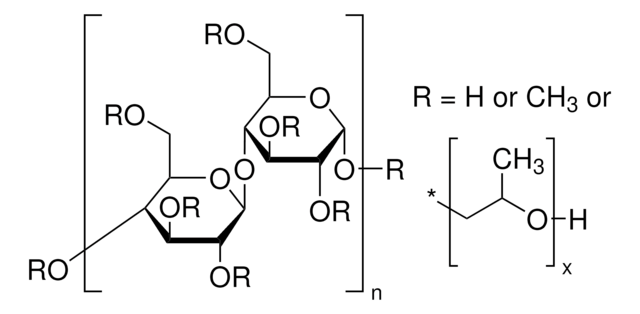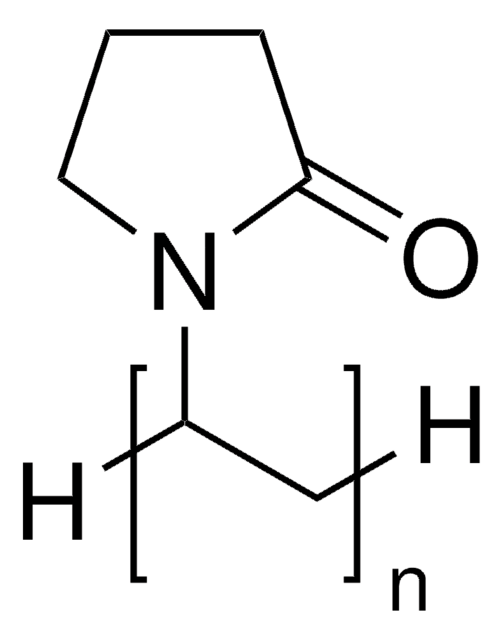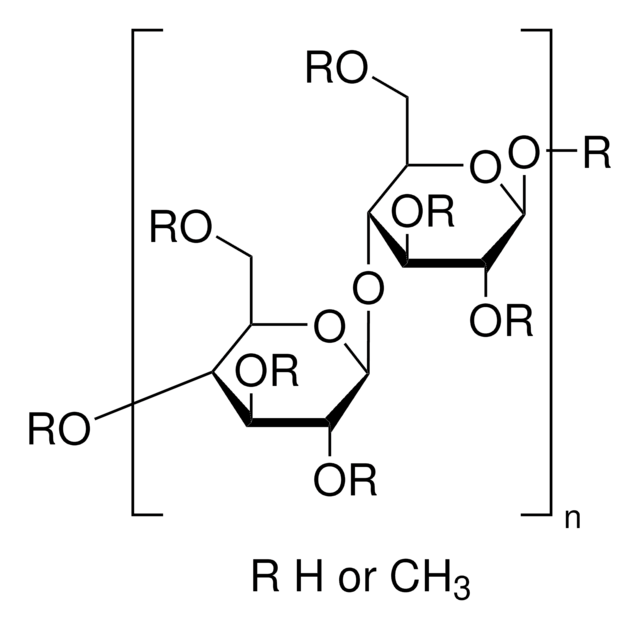추천 제품
양식
powder
Quality Level
분자량
~22 kDa
색상
beige
점도
40-60 cP, 2 % in H2O(20 °C)(lit.)
solubility
water: 10 mg/mL, clear to slightly hazy
저장 온도
room temp
SMILES string
O3[C@H]([C@@H]([C@H]([C@@H]([C@H]3COCC(O)C)OCC(O)C)OCC(O)C)OCC(O)C)O[C@@H]4[C@H](O[C@H]([C@@H]([C@H]4OCC(O)C)OCC(O)C)OCC(O)C)COCC(O)C.O1[C@H]([C@@H]([C@H]([C@@H]([C@H]1COC)OC)OC)OC)O[C@@H]2[C@H](O[C@H]([C@@H]([C@H]2OC)OC)OC)COC
InChI
1S/C36H70O19.C20H38O11/c1-19(37)9-45-17-27-29(47-11-21(3)39)31(48-12-22(4)40)34(51-15-25(7)43)36(54-27)55-30-28(18-46-10-20(2)38)53-35(52-16-26(8)44)33(50-14-24(6)42)32(30)49-13-23(5)41;1-21-9-11-13(23-3)15(24-4)18(27-7)20(30-11)31-14-12(10-22-2)29-19(28-
InChI key
PUSNGFYSTWMJSK-GSZQVNRLSA-N
유사한 제품을 찾으십니까? 방문 제품 비교 안내
애플리케이션
특징 및 장점
제조 메모
Dispersion in hot water:
1. Heat approximately 1/3 the required volume of water to at least 90 oC.
2. Add the powder to the heated water with stirring or agitation.
3. Agitate the mixture until the particles are thoroughly wetted and evenly dispersed.
4. Add the remainder of the water (cold water) to lower the temperature of the dispersion. As the product cools, it will reach a temperature at which it becomes water soluble. It will then begin to hydrate and dissolve, increasing the viscosity of the solution.
5. Continue agitation for at least 30 minutes after the proper temperature is reached for solubility. The solution is now ready to use.
Dry blending:
1. Combine powder with other dry ingredients. The suggested ratio of dry powder to hydroxypropylmethylcellulose is 7:1 to 3:1.
2. Thoroughly blend the dry ingredients.
3. Add the dry mixture to water with agitation.
4. Agitate until the product has completed hydrated and the solution is consistently smooth. The solution is now ready for further processing/use.
Dispersion in non-solvent medium:
1. Hydroxypropylmethylcellulose may be dispersed in non-solvent media such as vegetable oil, polyethylene glycol, glycerin, corn syrup, and concentrated salt solutions. A ratio of 5-8 parts non-solvent to 1 part hydroxypropylmethylcellulose is recommended to obtain a liquid slurry.
2. Agitate the mixture until the particles are evenly dispersed.
3. This dispersion may be added to cold water or cold water may be added to the dispersion.
4. Continue mixing until the powder is completely hydrated and the solution is smooth. Additional ingredients may now be added to the formulation.
분석 메모
기타 정보
Storage Class Code
11 - Combustible Solids
WGK
WGK 1
Flash Point (°F)
Not applicable
Flash Point (°C)
Not applicable
개인 보호 장비
Eyeshields, Gloves, type N95 (US)
이미 열람한 고객
자사의 과학자팀은 생명 과학, 재료 과학, 화학 합성, 크로마토그래피, 분석 및 기타 많은 영역을 포함한 모든 과학 분야에 경험이 있습니다..
고객지원팀으로 연락바랍니다.



